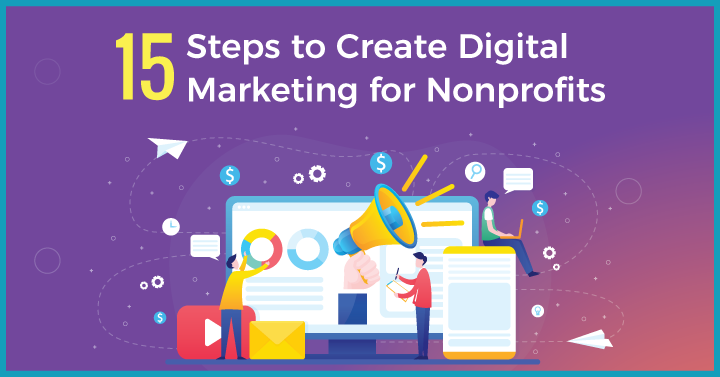Digital marketing for nonprofits is a vital tool for organizations to communicate directly with their target audience. There are several components of digital marketing such as websites, social media, SEO, email marketing, video marketing etc. Using some of these marketing channels that are backed by a strategic plan is how you will spread awareness for your nonprofit organization.
Now, the question is –
- How will you leverage the digital marketing channels?
- What type of content will you create?
- Which channels are you going to use?
You need a comprehensive digital strategy to answer these questions. According to sources, marketers that document their digital marketing strategy are 313% more likely to report success than those who don’t.
From establishing clearly defined goals to identifying target audience, understanding the market, creating your brand message, and determining the best tactics – there’s a lot to do.
This step-by-step guide discusses steps to create an effective strategy that helps you reach a larger audience and increase your nonprofits revenue.
1. What Is Nonprofit Marketing?
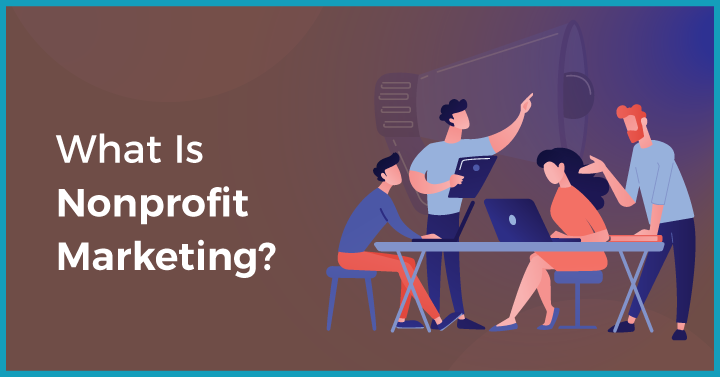
Nonprofit marketing can be defined as the use of strategies and tactics to promote the interests of a nonprofit organization. To market a nonprofit, you need to communicate about the work and convince them to take a particular action.
Like any other organization, marketing is vital for nonprofits to target potential donors, volunteers, and supporters. It works by serving multiple functions like – creating awareness, promoting a cause, fundraising, encouraging memberships, engaging volunteers, and driving social change.
2. Do Nonprofits Need Digital Marketing?
Yes. Like any other organization – nonprofits, too, need digital marketing. It is an inevitable resource for nonprofits that want to maximize their growth.
Digital marketing for nonprofits ensures your message reaches the right audience, including – potential donors, prospective volunteers, or people who utilize your services. Nonprofits who follow a well-thought-out digital marketing plan can grow faster, grow members, increase donations, raise awareness, and strengthen engagement.
With the right mix of digital marketing tools and a bit of a learning curve, you can boost your marketing reach with a lesser effort.
3. 15 Steps to Create Digital Marketing for Nonprofits
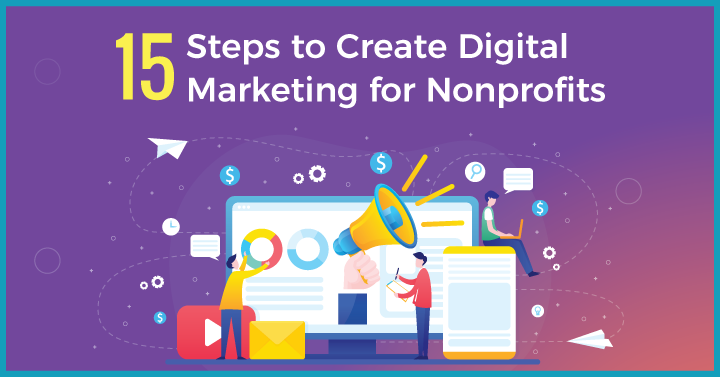
3.1 Determine the Goals
The first step in building a digital marketing strategy for NGOs should be defining the goals. Begin with listing your goals, such as –
- We’d like to increase brand visibility
- We’d like to drive more online donations
- We’d like to attract more volunteers
- We’d like to raise public awareness
The goals of digital marketing for nonprofits can be many. But, at the top of the list is brand visibility, which will eventually drive more online donations and attract more volunteers.
Once you determine the goals, the next step is to build strategies that align with your goals. Start with SMART (Specific, Measurable, Achievable, Realistic, and Time-based) goals that will ensure you have clear objectives for stakeholders, volunteers, donors, and the community.
For instance, your main objective is to increase brand awareness. Your SMART goals could be –
- 50% increase in blog traffic in the next three months
- 25% increase in social media shares in 2 months
- 2,000 video views on your YouTube channel in 4 months
Once you have determined the SMART goals, your marketing team will do activities to lead to their success. Remember that the SMART goals should match your ultimate objective. Therefore, you need to understand the current benchmarks and estimate the best course of action.
3.2 Define Audience and Web Personas
Once you have determined the goals, the next step is to understand your target audience for your campaigns. For instance, your nonprofit may want to target donors, volunteers, or partners. You need to customize the campaigns to target individual segments.
Conduct online research into their demographics, location, interest, and lifestyles. Segment your audience into groups and personalize your message to suit the segment. An easy way to build an audience for your nonprofits is to start with a list of actions you want the people to take. Some of the activities you can list include –
- Making donations
- Buying tickets for charity shows
- Signing up as a volunteer
- Registering as a sponsor
When the above activities are translated into a specific audience, you will have – volunteers, donors, business owners, etc. These are nothing but personas (a fictional representation of actual users) that your marketers envision as someone likely to respond to the marketing strategies.
Once you have created a persona, start crafting messages to connect with them.
3.3 Build a Responsive Website
With so many interactions online, a nonprofit organization should have a responsive website that includes critical information like – objectives, mission, how the visitor can help, etc. It also hosts critical digital assets such as blogs, event information, social media streams, videos, etc.
Having a user-friendly, aesthetically pleasing, and fast-loading website can help increase organic search traffic. In addition, your website will become a tool to engage your visitors and convert them to donors or volunteers.
According to statistica, 54.4% of global website traffic comes from mobile devices. Therefore, to reach a wider audience, one should build a responsive website for your nonprofit organization.
For example, Habitat for Humanity designed an excellent responsive website that shares educational content, mission, latest news, event information, etc. The website also informs the visitors on how to get involved in their volunteer & support programs.
3.4 Setup Analytics and Search Console
The next step in digital marketing for nonprofits is to optimize the website for search engines. Google Analytics and Google Search Console come under the best SEO tools that help you make your website Google-friendly and healthy. In addition, these tools help you diagnose technical issues and understand which marketing strategy works for you.
Create your account on Google Analytics. Then, install the javascript snippet onto your nonprofit website so that you can start collecting data about your website visitors.
Join Google for nonprofits that offer free programs like G-Suite, YouTube Nonprofit, and Google Ad Grants.
Establish goals that help you understand how effectively your website achieves these goals.
For example, you can configure a custom goal that takes the visitor to the thank you page after filling out a form, making a donation, or providing contact information.
To improve the performance of your website on google search, connect it with Google Search Console. First, you need to create an account and link it to your analytics account.
Besides, you can connect your Google ads account with Analytics to understand how your ads perform.
All these metrics will help you know if your digital marketing strategy for NGO is aligned with your business goals or if any changes are required.
3.5 Perform Keyword Research
The next important step in search engine optimization is keyword research. The main goal of SEO is to increase the chances of your website showing up in relevant search results and increase website traffic.
When someone searches for a phrase or a closely related one, you want your website to appear at the top of SERP.
But, how do the search engines like Google and Bing know that your website offers information about that topic?
Using keywords effectively in the website content signals the search engines. If the Google algorithm determines that the website content matches what the searcher is looking for, you are on your way to SEO success.
A little brainstorming can get you well on your way to a bunch of keywords. Start by making a list of words or phrases related to your organization.
Let us take an example of a human welfare organization. You may come up with some of the following aspects –
- What type of activities do they do?
- Causes they support
- How do the donors get involved?
- Ways the volunteers help
The nonprofit organization will better understand the keywords or phrases to explore. To dive deeper, put your target audience’s persona into practice.
Use tools such as Google Keyword Planner, UberSuggest, SEMRush, etc., to expand the list of keywords. To evaluate the quality of keywords, check the average monthly searches and competition. One should choose keywords with high search volume and low/medium competition.
Picking the right keywords will help you connect your nonprofit with your target audience.
3.6 Build Quality Backlinks
When it comes to organic SEO, link building is essential. It is the process of getting external links to your website. When your nonprofit website links to other sites, Google crawlers can easily navigate to your website via external links.
Your nonprofit site will likely land on top SERP results with tons of quality backlinks. Create valuable content to get other websites to link to your website. Here are some tips that speed up your link-building process –
- Write guest posts for high-authority websites
- Share facts collected by your organization
- Create visual content like infographics
- Add social share buttons to blog posts
- Ask corporates, sponsors, and other nonprofits to link to your website
To improve your visibility in the local community, you must claim your Google My Business and Yelp listings.
As a nonprofit, you can always be asking for support from stakeholders and donors. Search on social media platforms to collaborate or partner with other organizations.
3.7 Develop a Strong Content Strategy
For a nonprofit organization, content marketing is a valuable asset. It educates the audience about the cause, mission, and industry trends. Also, it drives new visitors, donors, subscribers, and leads. However, it can be tough to cut through the noise with your content with millions of online resources.
You need to think about the donors, such as –
- What do your donors want to know?
- What are the frequently asked questions?
- What content do they engage with on social media?
You can use Reddit, Ask the Public, or People also Ask to find frequently asked questions. You could develop a content strategy that provides solutions to the pain points of your target audience.
Content is an appreciating asset that one can reuse and repurpose repeatedly. So, you could align your content strategy with your marketing objectives. According to sources, 76% of nonprofits employ content marketing tactics. Unlike promotional articles, blog posts can draw the target audience’s attention.
For example, you can talk about the latest trends, news, and events within the sphere. It is an excellent way for nonprofit marketers to educate their audience and, at the same time, climb search engines.
Besides, blog/newsletter subscriptions are vital for promoting content to various audiences such as volunteers, first-time/repeat donors, advocates, etc. A subscription allows you to push content to the target audience without depending on them to return to your website voluntarily.
March of Dimes is the best nonprofit advertising example. The organization used a multi-dimensional content marketing approach to content marketing. From inspirational and life-changing stories to Youtube videos and Twitter announcements, they created a unique content strategy that aligns with their mission.
3.8 Explore PPC Advertising
Did you know – nearly 1.4 billion people worldwide donate to a nonprofitable cause? Yet, despite the growing number of donors, it is still a challenge for nonprofits to reach their goals.
PPC advertising is a highly lucrative source of donations for nonprofits and NGOs. Pay-Per-Click or PPC advertising can be a highly effective revenue stream for nonprofits if used well. One can strengthen their leads and get more website traffic, which will increase participation and funding.
If your nonprofit organization isn’t purchasing ad space, you are missing out on an untapped audience. Google offers qualified nonprofits $10,000 per month through Google ad grants. This program is designed to help nonprofits and NGOs to boost their online presence without breaking the bank.
All you need to do is –
- Join Google for nonprofits
- Confirm you have a valid status
- Make sure you have a robust website
- Agree to Google’s terms & conditions
Once you have received the Google ads grant, you must be regular in posting Google ads. Remember that the ads must promote the mission of your nonprofit organization.
3.9 Having a Strong Presence on Social Media
There are several tools and resources for nonprofits on social media. Most channels, including Facebook, Instagram, Twitter, Linkedin, Pinterest, etc., offer unique features and support eligible nonprofits.
Some best practices to promote your nonprofit organization on social media include –
- Setting up accounts on multiple platforms as nonprofits
- Creating a content calendar with blogs, success stories, videos, testimonials, and events
- Making use of donation buttons and trending hashtags
- Launching a fundraiser campaign
- Hosting online events, polls, surveys, etc
Leverage ‘newsjacking’ – a unique tactic to boost your brand awareness efforts. Many people turn first to social media for the latest news and information.
Your followers may want to see how their favorite nonprofit or NGO reacts to the current situation. You can let your target audience know that you are current and keep them engaged through your blogs, email marketing, or social media posts.
Here is an example of a nonprofit that utilized social media to the best.
In a single campaign, SickKids Foundation linked two newsworthy topics: Mother’s day and Covid-19, which gained immense popularity. The post went viral and grabbed the attention of millions. Also, it helped them in raising huge funds.
3.10 Invest in Social Media Advertisements
Social media advertising, also known as social media targeting, is a direct way to reach a target audience. It can provide a massive increase in conversions if the target market for your nonprofit aligns with the demographics of social media platforms.
You can effectively invest 100% of your budget in social media advertising, from marketing campaigns to different ads. Let us look at different types of advertisements on social media –
Photo Ads – They help your nonprofit achieve three broad types of campaigns that build brand awareness, increase engagement, and boost conversions.
Video ads – Video ads range from short to lengthy promoted videos that stand out in classic news feed. With higher completion reach, short video ads are great for in-the-moment marketing.
Stories ads – In stories ads, the photos and videos last for a few seconds before they disappear. It can stand out in the news feed if you’ve got a compelling message.
Carousel ads – Carousel ads let you include upto ten images or videos with a unique link. They are great for presenting multiple products or services.
Slideshow ads – These ads offer a compelling motion of video created from several static images. It allows people to learn more about your nonprofit organization.
When it comes to digital marketing for nonprofits, social media advertising is one of the most efficient ways to reach target audiences and convert them into donors or volunteers.
3.11 Engage Audience Through Personalized Mailers
Email marketing is no more viewed as a tool for businesses looking to generate revenue. Instead, from donation drives to event updates, emails offer nonprofits an efficient way to reach supporters. With some distinct advantage over other marketing channels, 69% of nonprofits worldwide publish newsletters and engage their audience.
When discussing a cause or communicating the importance of a mission, compelling and personalized messages are extremely important. According to a study, personalized emails can generate 6x more donations compared to non-personalized emails.
From event invitations to newsletters, donation appeals, thank you emails, and retention emails – automating the mails can keep the audience engaged.
Here is an example to know how nonprofit organizations can use email marketing.
Recently, St. Jude Children’s Research Hospital ran an email marketing campaign that provided a detailed schedule of their events in downloadable format, making it easier for readers to save the information so they don’t forget it. Also, the newsletter in which they displayed how far the last year’s donations went was impactful.
3.12 Connect with Local Community
One of the important rules of nonprofit marketing is to meet the audience where they are. Social media platforms are the best places where your target audience is most active. The best way to connect with the local community via social media is to listen to their challenges, interests, struggles, passions and musings.
Besides, social media groups are great for facilitating conversation in a focused setting. From volunteers to advocates and supporters, you will find your audience in social media groups. Here are some ways to foster similar connections and keep them engaged –
- Find opportunities to initiate a discussion potential supporters
- Invite followers to join and start open conversations.
- Participate in local events to get to know more about your community
- Understand the issues of your community and be an active partner
- Consider hosting seminars, events, training, and meetups
- Pull together a group of energized individuals to engage
Connecting with a community from scratch seems overwhelming for your nonprofit organization. You can attach your organization to pre-existing communities and leverage the benefits.
3.13 Leverage the Power of Compelling Videos
Video marketing is a powerful tactic to raise brand awareness, connect with potential audiences, and convert them to donors. A compelling video can hook the viewer and keep them on your website for longer. Even though videos have the power to gain exposure and increase donations, most nonprofits find it challenging to build a scalable video strategy.
With the right tools in place, nonprofits can empower every person in their organization to share the message through videos. Check out some of the best video marketing tools like – VidiQ, VEED, Animoto, etc that enables you to create high quality videos.
Let’s take a look at specific videos to boost the visibility and reach of your nonprofit.
Storytelling videos – Nonprofit videos that show stories are practical tools for fundraising and rallying support. You can portray the stories of actual causes and people that were helped by your nonprofit.
Explainer videos – Explainer/animated videos are an excellent way for nonprofits. With compelling illustrations and quality motion, one can cover sensitive/difficult subject matters without showing real people.
Testimonial videos – These are a must-have for any nonprofit to communicate their message and give their audience a chance to hear from donors why they choose to associate with your organization.
Interview videos – Interview videos are great for nonprofits to inspire donors, volunteers, and supporters. They effectively spark inspiration no matter the cause, story, or mission.
Share your nonprofit videos through YouTube, Vimeo, Dailymotion, etc., to better connect with supporters.
3.14 Engage Donors With Retargeting
Retargeting is an advertising strategy that shows ads to people who recently visited your website. Retargeting can be a crucial tactic for nonprofits to increase brand awareness and boost fundraising.
According to sources, retargeted ads are 70% more effective than standard PPC or display ads. These ads remind the prospective donors or supporters of a page they have expressed interest in. As a result, you are more likely to see the visitor again on your website, make a donation, or register for an event.
To get the most out of retargeted ads, nonprofits can remind the prospects of upcoming events, abandoned donations, newsletter signup, etc.
3.15 Analyze Your Marketing Performance
Finally, nonprofits need to measure the campaign success with key metrics such as – website traffic, bounce rate, user engagement and more. One can track these metrics in Google Analytics and Search Console.
For example, the number of ‘email opens’ is the performance indicator of email marketing. Similarly, video views are the key metric to knowing the performance of video marketing.
A solid nonprofit marketing strategy looks at the result and considers the best course of action to reach that goal. A nonprofit is not selling a product but looking for funds, donations, volunteers, supporters, employees, etc.
Understanding critical analytics will help nonprofits better understand the trends and opportunities.
4. Sample Template of a Marketing Plan for NGOs
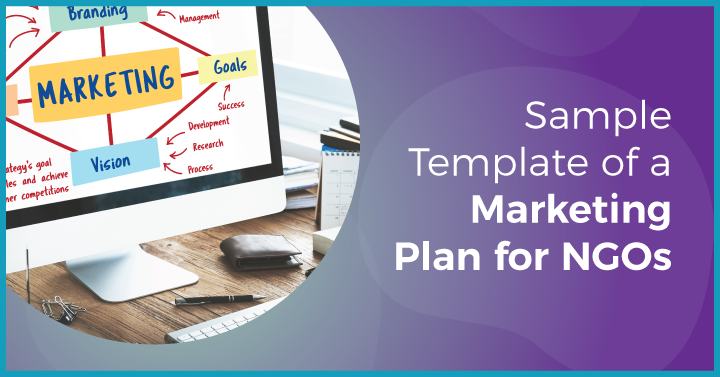
Company:
Date:
Executive Summary
The executive summary is a small, summarized version of your marketing plan that lists the relevant component
4.1 Goals Overview
What is your unique selling proposition? And what separates you from other nonprofits?What are your nonprofit marketing objectives?
4.2 Audience Overview
(Who are your target audience, donor segment and donor persona? What are the habits that describe the groups, segments and donor persona.)
4.3 Website Planning
(Include the layout and structure of your website, features, landing pages, call to actions etc.)
4.4 Setting up Google Analytics and Search Console
(Write about Google account details and the key metrics to monitor)
4.5 Keyword Research
(Include details of competitor analysis, identify short & long-tail keywords, search volume, competition and keyword difficulty.)
4.6 Build Quality Backlinks
(Plan and strategize how to build quality backlinks, the channels, DA, referral links etc. List out all the possible sites for effective link building.)
4.7 Content Strategy
(List the content ideas, topics, type of content to distribute, audience you are targeting, platforms etc.)
4.8 PPC Advertising
(Include details of advertising budget, campaigns, goals, messaging, etc)
4.9 Social media optimization
(Identify the social media channels to promote your NGO. Include details of social media calendar, type of content, images, messaging etc.)
4.10 Social media advertising
(What are the best social media channels to advertise and achieve your marketing goals?)
4.11 Email Marketing
(What will it take to implement an effective outbound marketing strategy?)
4.12 Social media Community
(What are your specific groups where you are likely to find your target audience? List out the ways to connect with your community.)
4.13 Video marketing
(Keep the target audience engaged with storytelling and explainer videos. What will it take to implement?)
4.14 Retargeting
(Retarget the audience who visit your website with specific ads with the goal of convincing them.)
4.15 Measure the success rate
(What are the specific KPIs to measure?)
5. Examples of Nonprofit Marketing
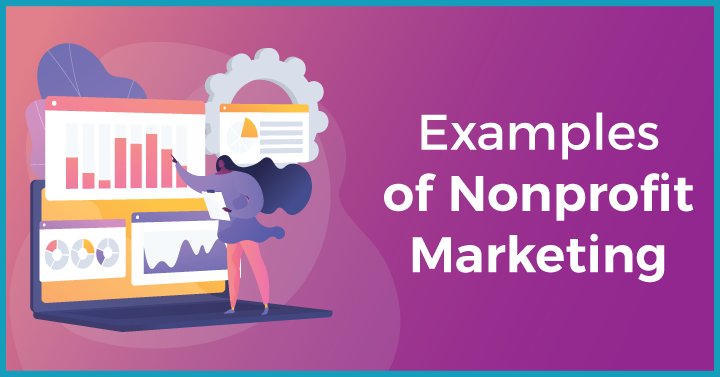
Here are some of the best nonprofit marketing examples that grabbed the attention of millions of donors, volunteers, and supporters worldwide.
This nonprofit organization encouraged participants to film an arm-wrestling competition and tag make-a-wish on social media. As a part of the world wish day campaign, the nonprofit organization wanted to raise awareness and generate funds online to fulfill the wishes of children diagnosed with critical illnesses. To use this idea, nonprofits can think of a fun activity and ask their followers to do it for their organization.
Feed My Starving Children is a nonprofit founded in 1987 that aims to break the cycle of poverty. The Minnesota-based charity spends more than 90% of the donations feeding kids. Every week, the NGO sends subscribers an update from their blog with a personal story of a child who was helped by their programs. The newsletter reminds the supporters that their work affects real children and that their contributions are valuable.
Charity: Water is a nonprofit organization established to bring safe and clean water to people in developing nations. The organization ran a Pledge your Birthday campaign that suggested that family members and friends donate to charity: water via social media to help build clean water projects. This idea encouraged its supporters to spread the word about the organization and even convinced many to donate and feel involved in the fundraising process.
6. FAQs
- Why do NGOs need digital marketing?
NGOs need digital marketing to build brand awareness, build global reach and achieve their goals.
- How do I market my nonprofit on social media?
Optimize your nonprofit’s profile on social media and post engaging content regularly. Connect with your target audience by responding to their comments and keeping them updated.
- How often should a nonprofit post on Facebook?
Nonprofits can post 2-3 times a week to engage their target audience
- Are google ads free for nonprofits?
The Google ads grant program provides free ad credits to qualified charitable organizations.
7. About Us
Growth Ganik is a rapidly evolving digital marketing agency in Sydney, Australia that specializes in SEO, content marketing, marketing strategy and lead generation.
We work with clients from leading brands and industries such as B2B SaaS, nonprofits and more to develop profitable digital marketing solutions that are data-driven to support all kinds of business goals from widening user bases, gaining more traction for online engagement, to increasing conversion and helping businesses scale up.
For creative tailor-made digital solutions and sustainable growth insights, get in touch with us!

